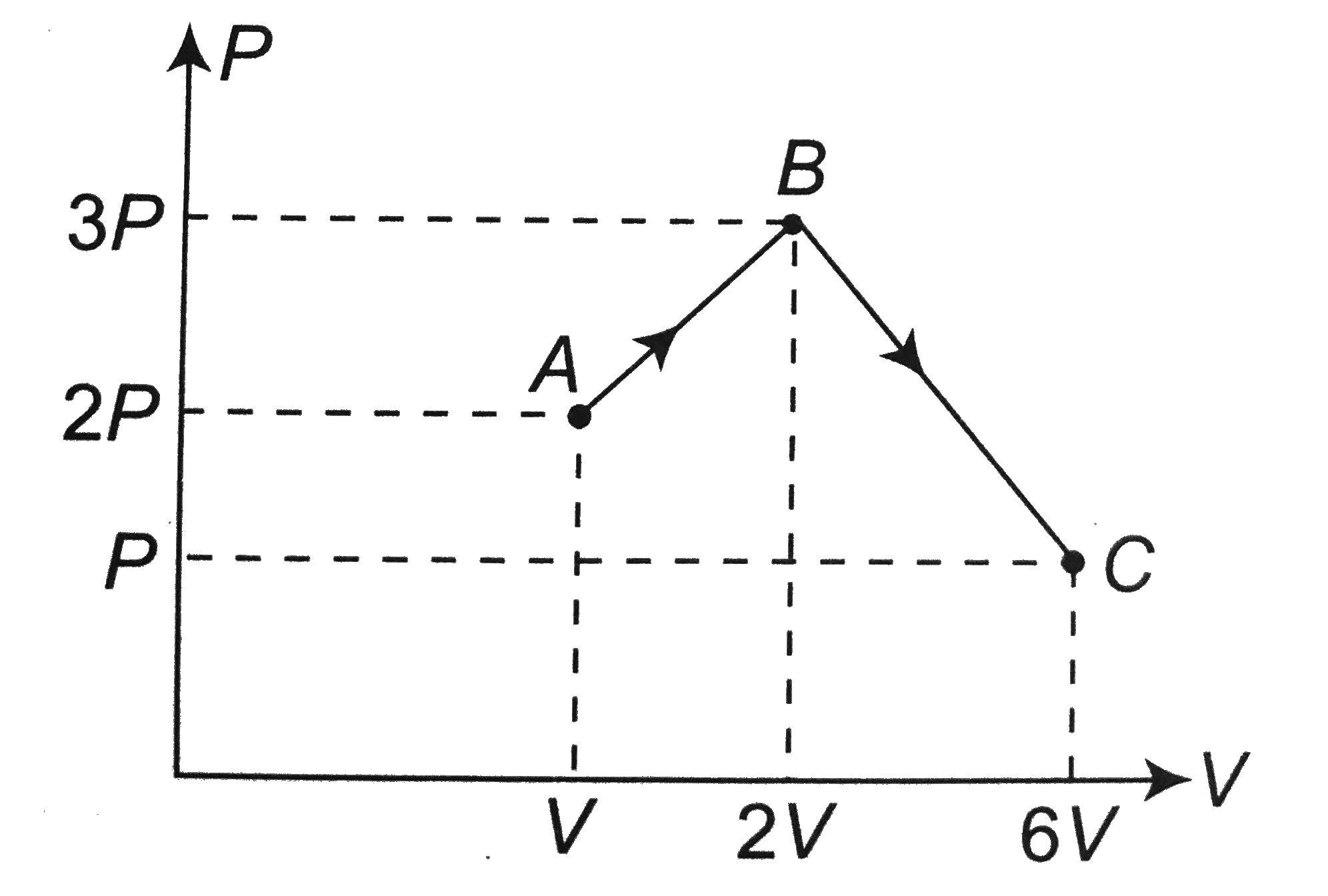A diatomic ideal gas initially at 273 K is given 100 cal heat due to which system did 209 J work. Molar heat capcity (Cm) of gas for the process is :
32R
52R
54R
5 R
The correct Answer is:D
To solve the problem step by step, we will follow the principles of thermodynamics and the properties of an ideal gas.
1. Convert Heat from Calories to Joules:
Given that the heat absorbed by the gas is 100 cal, we need to convert this to joules.
Q=100cal×4.184Jcal=418.4J
Hint: Remember that 1 calorie is equivalent to 4.184 joules.
2. Identify Work Done:
The work done by the system is given as 209 J. According to the convention, work done by the system is considered negative in the first law of thermodynamics:
W=−209J
Hint: Work done by the system is negative when the system does work on the surroundings.
3. Apply the First Law of Thermodynamics:
The first law states:
ΔU=Q+W
Substituting the values we have:
ΔU=418.4J−209J=209.4J
Hint: The change in internal energy is the sum of heat added to the system and the work done on the system.
4. Determine the Change in Internal Energy for a Diatomic Gas:
For a diatomic ideal gas, the change in internal energy can be expressed as:
ΔU=CVΔT
where CV=52R for a diatomic gas.
Hint: The molar heat capacity at constant volume for a diatomic gas is derived from its degrees of freedom.
5. Relate Change in Internal Energy to Temperature Change:
We can express the change in temperature as:
ΔT=ΔUCV=209.4J52R
Hint: Rearranging the equation helps isolate the temperature change.
6. Express Heat Exchange in Terms of Molar Heat Capacity:
The heat exchange can also be expressed as:
Q=CmΔT
Equating the two expressions for Q:
418.4J=CmΔT
Hint: You can relate the heat absorbed to the molar heat capacity and the change in temperature.
7. Substituting for ΔT:
Substitute ΔT from step 5 into the equation:
418.4=Cm⎛⎝209.452R⎞⎠
Rearranging gives:
Cm=418.4⋅52R209.4
Hint: Simplifying this expression will lead you to the molar heat capacity.
8. Calculate Molar Heat Capacity:
Simplifying the expression:
Cm=418.4⋅5R2⋅209.4=5R
Hint: The final expression shows that the molar heat capacity for the process is directly proportional to the gas constant R.
Final Answer:
The molar heat capacity Cm of the gas for the process is:
Cm=5R
Given that the heat absorbed by the gas is 100 cal, we need to convert this to joules.
Q=100cal×4.184Jcal=418.4J
The work done by the system is given as 209 J. According to the convention, work done by the system is considered negative in the first law of thermodynamics:
W=−209J
The first law states:
ΔU=Q+W
Substituting the values we have:
ΔU=418.4J−209J=209.4J
For a diatomic ideal gas, the change in internal energy can be expressed as:
ΔU=CVΔT
where CV=52R for a diatomic gas.
We can express the change in temperature as:
ΔT=ΔUCV=209.4J52R
The heat exchange can also be expressed as:
Q=CmΔT
Equating the two expressions for Q:
418.4J=CmΔT
Substitute ΔT from step 5 into the equation:
418.4=Cm⎛⎝209.452R⎞⎠
Rearranging gives:
Cm=418.4⋅52R209.4
Simplifying the expression:
Cm=418.4⋅5R2⋅209.4=5R
The molar heat capacity Cm of the gas for the process is:
Cm=5R
Topper's Solved these Questions
- BOOK - MOTIONCHAPTER - THERMODYNAMICSEXERCISE - EXERCISE - 2 (LEVEL-II)6videos
THERMODYNAMICS
- BOOK - MOTIONCHAPTER - THERMODYNAMICSEXERCISE - EXERCISE - 2 (LEVEL-II ASSERTION REASON)6videos
THERMODYNAMICS
- BOOK - MOTIONCHAPTER - THERMODYNAMICSEXERCISE - EXERCISE - 133videos
THERMODYNAMICS
- BOOK - MOTIONCHAPTER - THERMOCHEMISTRY EXERCISE - Exercise - 4 Level-II8videos
THERMOCHEMISTRY
Similar Questions
"600J" of heat is added to a monatomic gas in a process in which the gas performs a work of "150J" .The molar specific heat capacity of the gas for the process is
View SolutionIf Q amount of heat is given to a diatomic ideal gas in a process in which the gas perform a work 2Q3 on its surrounding. Find the molar heat capacity (in terms of R) for the process.
View Solution
Knowledge Check
- Question 1 - Select One
A diatomic ideal gas initially at 273 K is given 100 cal heat due to which system did 209 J work.
Molar heat capacity (Cm)n of gas for the process is :A32RB52RC54RD5 R - Question 2 - Select One
An ideal gas with adiabatic exponent (γ=1.5) undergoes a process in which work done by the gas is same as increase in internal energy of the gas. Here R is gas constant. The molar heat capacity C of gas for the process is:
AC=4RBC=0CC=2RDC=R - Question 3 - Select One
In a thermodynamic process on an ideal diatomic gas, work done by the gas is η times. The heat supplied (η<1). The molar heat capacity of the gas for the process is
A5R2B5ηR2C5R2(1−η)D5R(1−η)2
An amount of heat is added to a monatomic ideal gas in a process in which the gas performs work Q2 on its surrounding. Find the molar heat capacity for the process.
View SolutionFind the value of molar heat capacity for an ideal gas in an adiabatic process.
View Solution600J of heat is added to a monoatomic gas in a process in which the gas performs a work of 150J. The molar heat capacity for the process is
View SolutionFor polytropic process PVn = constant, molar heat capacity (Cm) of an ideal gas is given by:
View SolutionA monoatomic ideal gas undergoes a process ABC. The heat given to the gas is
 View Solution
View Solution

